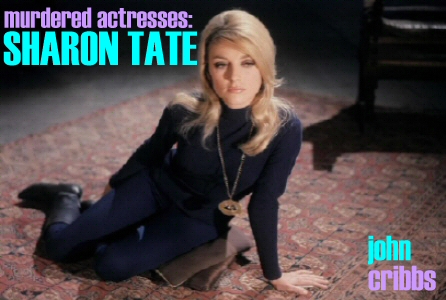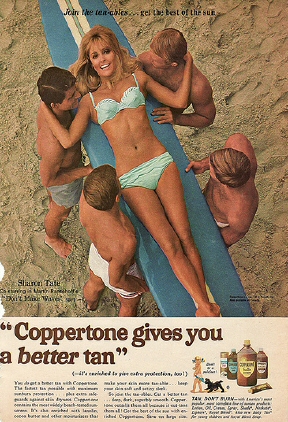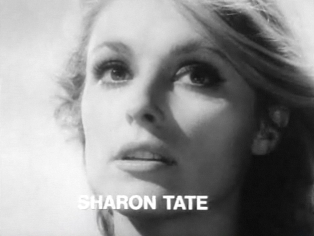
SHARON TATE: EYE OF THE DEVIL
john cribbs

August 9, 1969 - Los Angeles
On July 20, 1969, actress Sharon Tate invited her family to 10050 Cielo Drive, a house she rented with her husband Roman Polanski, to watch the moon landing. Huddled with loved ones at the foot of her bed, eight months pregnant with her first child and at the height of her and Polanski's careers, Tate must have felt a particular elation at the prospects of the future as she witnessed Neil Armstrong move slowly across the unfathomed rock on her TV set. With her husband developing a new project in London, she stalled a little in dismissing her guests. But eventually they waved goodbye, exiting into the heat of the Los Angeles summer night, unaware that they’d never see Sharon alive again.
Today, August 9th, marks the 40th anniversary of the infamous "Helter Skelter" murders committed by members of the so-called Manson family at the Cielo Drive address in Benedict Canyon. The crime occurred shortly after midnight and resulted in the brutal deaths of five people including Tate, who was 26 years old. In the initial wake of the murders, theories abounded as to what had happened: many blamed Tate's perceived wild "Hollywood life" and speculated a drugged-out celebrity orgy gone horribly wrong. But the true details of the crime turned out to be even more senseless than anything a gossip monger could contrive. It sent ripples of panic through the film community and would end up a media circus that led Joan Didion to commemorate August 9th 1969 as "the day the 60’s ended."
Like many true crime scholars, I've studied the case of Charles Manson and the seven murders that took place over that weekend in Los Angeles, a macabre series of random crimes that continue to fascinate and baffle today. While I find equally upsetting the poor timing of Steve Parent's departure from the house, the particularly gruesome slaying of Abigail Folger and Voytek Frykowski on the lawn where they attempted to flee and Jay Sebring's gallant attempt to defend his fellow victims, it was always beautiful Sharon Tate who took center stage in the tragedy. Made more famous in death than she was in life, Sharon would come to represent a new kind of public figure: the murdered actress.
This week I'll be writing about seven actresses who met violent, untimely deaths over the last forty years. I've been mulling over the purpose of this series in my head for the last couple weeks. The intent is not to sentimentalize their lives, nor to exploit their deaths. I won't be languishing too long on the details of their murders: mainly, I'll be selecting films of theirs to review. These aren't homages per se: in choosing subjects to write about on this site I pretty much look for any excuse to see new films or review old favorites. And seriously, what other excuse am I going to come up with to watch The Wasp Woman and Barbarian Queen II? Since this particular subject is integrated with my interest in true crime, I decided it made some kind of sense – it's at least something I find interesting. In an attempt to avoid any sort of cynical Hollywood Babylon-like treatment of any of these women, let me just get this out of the way: I don't believe that the fates of these actresses define their lives or careers. The devastation of their deaths (like any death) leads to renewed interest in their work, and it's the work that I'm mainly interested in.
 I'm not going to go into full-blown biographies in this series (anyone interested can check out Wikipedia). But as Vincent Bugliosi said, "Much of Sharon Tate's story sounded like a studio press release." She was a military brat who got her first recognition posing atop a bomb for a Dr. Strangelove-esque photo in an issue of Stars and Stripes while attending high school in Verona. She started popping up as an extra in Hollywood productions filming in Europe and landed an agent through another actor on set. She was signed by Filmways Inc., kept under the cover of a brunette wig on television until they could get her into a featured role on the big screen. The first of these was in Eye of the Devil, the film I'm reviewing for this week's first entry.
I'm not going to go into full-blown biographies in this series (anyone interested can check out Wikipedia). But as Vincent Bugliosi said, "Much of Sharon Tate's story sounded like a studio press release." She was a military brat who got her first recognition posing atop a bomb for a Dr. Strangelove-esque photo in an issue of Stars and Stripes while attending high school in Verona. She started popping up as an extra in Hollywood productions filming in Europe and landed an agent through another actor on set. She was signed by Filmways Inc., kept under the cover of a brunette wig on television until they could get her into a featured role on the big screen. The first of these was in Eye of the Devil, the film I'm reviewing for this week's first entry.
Eye, a co-production between MGM's American and UK offices, was filmed in England in 1965 by the great journeyman director J Lee Thompson. Thompson is most famous for the original Cape Fear and The Guns of Navarone, but for me his most interesting era was his period working with Charles Bronson, a nine-film venture which ran from 1977 to 1989. His only straight-up horror film (he had previously adapted a William Peter Blatty novel but it was a comedy), Eye of the Devil is laden with witchcraft, occultism, black magic, small village conspiracies and ritual sacrifice but at its center is the story of a woman desperate not to lose her husband. David Niven is a London-based vintner who learns the vineyards are failing at his ancestral grounds of Bellenac castle in France. He makes a hasty and melancholy departure, forcing wife Deborah Kerr to pack up the two kids and follow, despite the warning that locals at Bellenac "resent outsiders."
It doesn't take long after Kerr's arrival for this to be validated. Besides being politely shut out of affairs of the estate by her husband's aunt and summarily dismissed as an ignorant foreigner by creepy priest Donald Pleasance, she's menaced by large groups of field workers who stand among the crops staring at her motionlessly (no wonder the vineyards have failed – get back to work!) Her husband grows further and more distant from her, drowning deeper into a mysterious despondency. And to make matters worse, two weirdoes in black are roaming the grounds turning toads into doves and then shooting them with a bow and arrow.
 "Sharon was asked to play this very difficult role, of a rather witchlike person," Thompson stated in All Eyes on Sharon Tate, a studio-produced short publicizing its potential new starlet. "It was asking a newcomer to do a lot. She (took) direction beautifully. Very soon she began to realize that the camera was a friend." It's evident in the first of her two major scenes that the feeling was mutual. As castle groupie Odile de Caray, Tate is gorgeously framed and luminously photographed in black and white; her onscreen presence is effortlessly mesmerizing. Clad in black tights with high boots and jagged-stone medallion around her neck, her hypnotic movements are mirrored by the camera. Previously stuck in radically-angled (read: tilted) but static shots of other actors, the movie comes alive in Tate's close-ups. She moves her head and the camera follows, but wearily – because her eyes stay in the same place. What Thompson referred to in the short as Sharon's "star projection" is actually something more controlling: while her character's dialogue bewitches Kerr, her residence alone is enough to determine the motion of the shot.
"Sharon was asked to play this very difficult role, of a rather witchlike person," Thompson stated in All Eyes on Sharon Tate, a studio-produced short publicizing its potential new starlet. "It was asking a newcomer to do a lot. She (took) direction beautifully. Very soon she began to realize that the camera was a friend." It's evident in the first of her two major scenes that the feeling was mutual. As castle groupie Odile de Caray, Tate is gorgeously framed and luminously photographed in black and white; her onscreen presence is effortlessly mesmerizing. Clad in black tights with high boots and jagged-stone medallion around her neck, her hypnotic movements are mirrored by the camera. Previously stuck in radically-angled (read: tilted) but static shots of other actors, the movie comes alive in Tate's close-ups. She moves her head and the camera follows, but wearily – because her eyes stay in the same place. What Thompson referred to in the short as Sharon's "star projection" is actually something more controlling: while her character's dialogue bewitches Kerr, her residence alone is enough to determine the motion of the shot.
In her first major scene, Kerr’s children find Tate sitting by a pond outside the castle. She disparages Kerr’s prediction of rain with the slow and enchanting declaration: "If it does the rain will not last, madam. These are not life-giving clouds." Life, as it develops later on in the film, has a natural partner in death. Just as Odile magically transforms an ugly toad into a handsome dove, her brother Christian (David Hemmings, looking more androgynous than ever) uses his archer skills to slay the birds, which the siblings then offer as sacrifice in pagan rituals in the deep bowels of the castle. To them, the cycle of life at Bellenec is simple: you were created here, you were nurtured by us, and in turn you must resign the life we've given you to allow nature to flourish. This is bad news for Niven, whose role in tending to the failing harvest may involve a little more than just walking around the fields squeezing grapes. He's part of something bigger – ancient, according to Pleasance – something Kerr is trying to uncover and everybody else is trying to keep her from meddling with, which Tate has been assigned to scare her away from.
<<Previous Page 1 2 Next Page>>
home about contact us featured writings years in review film productions
All rights reserved The Pink Smoke © 2009